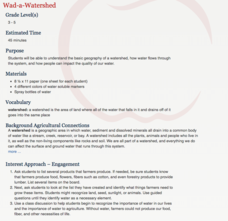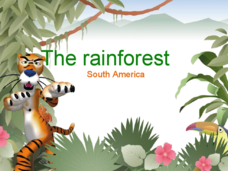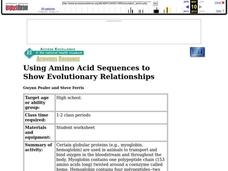New York State Department of Environmental Conservation
Adaptations – Designs for Survival
What's the difference between behavioral adaptations and physical adaptations? Learn about the various ways that organisms adapt to their environment with a worksheet about the creatures of the Hudson River.
University of Southern California
What Lives In The Ocean?
One of the most diverse environments on Earth is the ocean. Young scientists explore the living things found in the ocean during an exciting seven-lesson unit. Their study includes organisms from plankton to invertebrates and vertebrates...
American Museum of Natural History
Crazy Camouflage
Scholars discover the crazy camouflage technique of the flounder fish. After reading three informative paragraphs, participants follow steps to make a model of the sea creature.
American Museum of Natural History
What is Marine Biology?
A marine environment covers the majority of the earth but is arguably the least understood. Teach young scientists about the characteristics of oceans and ocean species using an interactive online lesson. The in-person or remote learning...
August House
The Clever Monkey Rides Again
Use a West African folktale to practice several different skills in your first grade classroom. Learners read The Clever Monkey Rides Again and focus on rhyming words, reading comprehension, measurement, art, movement, and word order.
Agriculture in the Classroom
Wad-a-Watershed
What kind of impact do humans have on watersheds? Find out in a instructional activity that defines, explores, and promotes ways to protect our watersheds. The ultimate goal of the instructional activity is for learners to discover how a...
K5 Learning
Landforms
Valleys, mountains, and plateaus are just a few geographic landforms on our Earth. Read about these types and more in a brief landform passage. After reading, learners respond to six short answer comprehension questions.
Space Awareness
Fizzy Balloons - C02 in School
Carbon dioxide is a very important gas; it is present in the air, used in cooking, and supports plant and animal life. Scholars investigate the properties of carbon dioxide with three different activities. They experience a color change,...
Syracuse University
Erie Canal
While canals are not the way to travel today, in the first half of the nineteenth century, they were sometimes the best way to move goods and people. Scholars examine primary sources, including maps and pictures, to investigate the role...
American Museum of Natural History
Ocean Creature Feature
From coloring to hard protective shells, ocean creatures have adaptation features that help them survive. An eight-question online quiz highlights different ocean animals and their unique characteristics. The resource then offers pop-up...
Curated OER
Animals A to Z: Orangutan
In this orangutan worksheet, 3rd graders will add pages to their "animal books." Students will read 10 facts to gain an understanding of an orangutan and its particular attributes.
Curated OER
The Rainforest: South America
What can one expect to see in the South American rainforest? Find out where humans sleep, what animals they encounter, what kind of plants they'll see, and what dangers lurk in the tall grasses and dense forests. This is a simple and...
Curated OER
Animals A to Z: Penguin
In this penguin worksheet, 3rd graders will add pages to their "animal books." Students will read 10 facts to gain an understanding of a penguin and its particular attributes.
Curated OER
Animals A to Z: Shark
In this shark worksheet, 3rd graders will add pages to their "animal books." Students will read 10 facts about a shark to gain an understanding of the animal's characteristics.
Curated OER
Animals A to Z: Urchin
In this sea urchin worksheet, 3rd graders will add pages to their "animal books." Students will read 10 facts about a sea urchin to gain an understanding of the animal's characteristics.
Curated OER
Adapting to the Dark-Bats and People
Students consider how cavers make adaptations to the cave as do bats.
Curated OER
Animals A to Z: Quoll
In this quoll worksheet, 3rd graders will add pages to their "animal books." Students will read 10 facts to gain an understanding of a quoll and its particular attributes.
Curated OER
To Your Health
Students read articles on health and read about how storks and other animals are cultural icons in bringing good health. In this health lesson plan, students also list ways to live a healthy lifestyle.
Curated OER
Using Amino Acid Sequences to Show Evolutionary Relationships
Compare protein fragments, count amino acids, and use the information to explore common ancestry. The resource mentions a student worksheet, however, a separate printable worksheet is not provided. The exercises are written into the...
Curated OER
To Tell The Truth
Students create a faux ivory napkin ring using art supplies and knowledge gained from in-class discussions and teacher supplied information in this art lesson easily adaptable to a Social Studies or Language Arts classroom.
Curated OER
An Elephant's Life
Here is an interesting worksheet that's all about elephants. In it, learners answer ten true-or-false questions about elephants, then respond to ten questions that come from a story about Daisy, the circus elephant. The questions should...
Curated OER
Fin, Feathers, or Fur?
Students learn how to classify animals. In this animal characteristics instructional activity, students read Granddad's Animal Alphabet Book, brainstorm a list of different kinds of animals, and determine their characteristics; fur,...
Curated OER
Water, Water Everywhere (Pond Animals)
Second graders examine the characteristics of animals who live in a pond environment. In groups, they describe the various stages in the life of a frog and identify the characteristics of other pond animals. Using this information,...
Curated OER
Sheltering and Caring for Animals
Students learn about animal shelters and adoption agencies. In this animal care lesson, students watch a video about the ASPCA and discuss what an animal shelter is, how it operates and what services it provides animals and the...

























